• Time to buy SGB1041 in ASW spread.
• Heading down. Continuing pressure on rates likely in a troubled environment.
Trades
- New, buy SGB1041 in an ASW spread at -90bp. Profit/loss targets: -110bp/-80bp. Carry-0.8bp/m. An alternative is to buy SGB1041 versus 2Y EUR swap.
- Profit taken. Implied forward ASW spread sell SWH183 buy SWH185 against matching forward swap at 190bp, closed at +158bp. Profit: +32bp. Profit taken. Receive 1Y1Y SEK versus pay 1Y1Y EUR at +113bp, closed at +96bp.Profit +17bp.
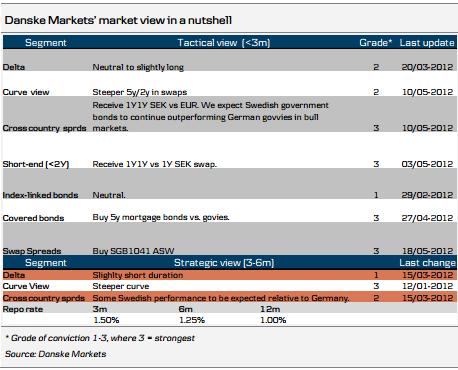
SGB1041 In An ASW Attractive
In the past few months, the ASW in SGB1041 has tightened somewhat. This might appear odd in the current unstable environment but it has been driven primarily by tighter TED spreads. A quick glance at historical developments shows that TED spreads are (unsurprisingly) well correlated with the SGB1041 ASW. Where do we go from here?
As we see it, SGB1041 is a loan that should be in high demand. Stable AAA-rated government bonds are not exactly plentiful and when SGB1046 matures in October this year SGB1041 is set to become the shortest government bond (apart from SGB1055 where there is only SEK9.5bn outstanding). This should increase demand from money market funds.
The demand from money market funds is naturally affected by flows into the funds. We see a pattern where softer equity performance leads to more flows into money market funds. Hence, we expect continued demand for short government bonds from these funds as the stock market is struggling (see charts).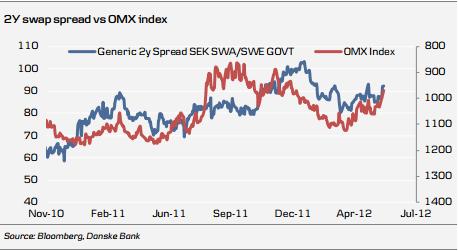
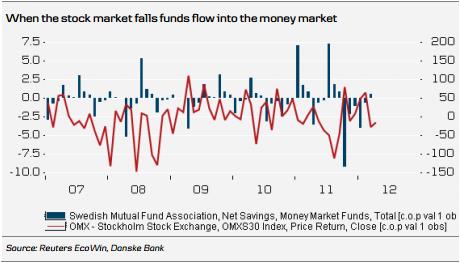
Moreover, as long as the acute crisis persists, foreign flows into the Swedish market should continue unabated. For investors that want to gain exposure to the currency, parking money in the shortest government bond is attractive. Moreover, under continued market tension, near convergence between Swedish and German government bond rates should gradually occur.
Surprisingly, SGB1041 has not been particularly well demanded in the repo market and has traded as GC. We see a strong likelihood that it could once again start to trade special, especially if more foreign accounts enter the Swedish market. These investors often want the currency exposure and thus have no interest in participating in the repo market. SGB1041 has previously traded up to 20bp expensive in the repo market compared with the Riksbank repo rate and we have no difficulty seeing SGB1041 moving towards these levels. This should directly affect the yield level in SGB1041.
It is also noteworthy that the 2Y-10Y curve has flattened significantly and trades close to previous range lows. We would not be surprised if more investors started entering curve steepeners. This would drain SGB1041 from the market, either in the form of cash bonds or indirectly through futures positions. Interestingly, the open interest in the 2Y is close to a multi-year low, indicating that market positioning in the 2Y segment is fairly small at the moment, which explains why SGB1041 has not been particularly demanded. 
Regarding TED spreads, even though we have no strong view in the short run, we believe fixings could be under upward pressure as we near the June IMM date. Cash tends to get more expensive around the IMM date and three covered bonds mature in June, with a significant amount of coupon payments due (around SEK60-70bn in total at the time of writing). Swedish fixings should definitely be affected if Euribor fixings fail to fall further, as has been the tendency over the last few days. 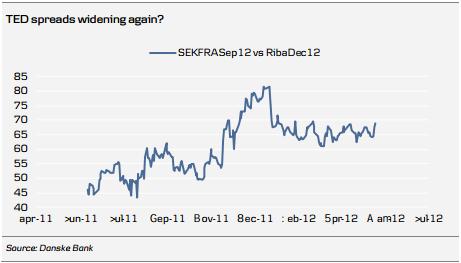
We recommend buying SGB1041 in an ASW at -91bp. Profit/loss target: -110/-80bp. Carry is slightly negative, around -0.8bp/month.
An alternative with more potential, and more risky, is to buy SGB1041 versus EUR swap instead. We believe in a gradual convergence in bond yield terms along the whole curve, at least in that direction – not necessarily in terms of the actual policy rate. In addition, the risk and uncertainties in the European banking system is mounting and might at some point move Euribor fixing up. The big uncertainty with such a strategy is whether the ECB and/or other central banks add more stimuli, i.e. more/cheaper liquidity. The question is how bad it can become before that happens.
Heading DownMost things, with the exception of the yield level being historically low, suggest that rates are likely to continue to move lower in the near-term. Currently, there is not much to suggest a sell-off. We believe that Swedish government and mortgage bonds are attractive from an international perspective as long as the foreign debt problem lingers on and the global business cycle shows signs of weakness.
The Swedish agenda is short on data in the coming week but several Riksbank Board
members will speak on the outlook for the Swedish economy. It is hoped they will give
clues on how they view the accelerating debt crisis in EMU. Even though they have had a
pretty harsh stance about the impact of European debt problems on the Swedish economy,
it would be surprising if they were not increasingly worried.
It is clear that financial market worries have escalated since the election results in Greece and France. The Greek election shows that a large portion of the Greek population takes a rather inconsequential approach to EMU membership and the austerity packages: they want to remain in the euro but at the same time they do not accept the austerity packages. Either Greek politicians have not explained clearly enough how this fits together, that you cannot have your cake and eat it, or they simply hope that the EU/ECB/IMF will continue to lend money, although Greece does not fulfill the requirements.Opinion polls are volatile but you cannot exclude the possibility that the anti-austerity parties with Syriza at the front will have a majority in the re-election on 17 June. If so, Greece would probably
have to leave the euro. Since the consequences of this for both Greece and other EMU countries are quite uncertain, recent market reactions seem quite understandable.
Moreover, the new French president François Hollande’s idea that there needs to be more emphasis on growth-oriented measures and less austerity is clearly attractive for people that have been hit by the current rough times. From an investor’s perspective, however, it means that many of the countries that have signed up to the new growth and stability pact, the so-called "fiscal compact," now risk deviating from their respective budget consolidations programs. That would hardly be seen as positive and uncertainty, arguably, has increased also in this respect.
The downgrade of Italian and Spanish banks recently and rising cross-country yield spreads do not improve the situation. It is becoming all the more uncertain whether the "fire walls" erected last year (the European Financial Stability Facility, European Stability Mechanism and possibly IMF money) are sufficient, as the cracks in the system appear to be widening and funding costs are again surging. In addition, it appears that the imbalances in the EMU’s payment system are continuing to grow: Target2 statistics reveal that the Bundesbank’s credit to other central banks (mainly Italy and Spain) amounts to more than EUR600bn, i.e. more than the ESM has at its disposal.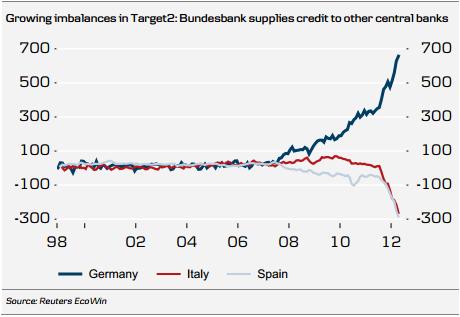
A more recent feature in the global economic picture is somewhat more shaky data from the USA. For instance, the US surprise index is slowly heading lower and is now starting to approach strained, although not alarming, levels. The US labour market has not been convincing lately and, hence, there is gradual uncertainty concerning the stability of growth prospects. This week there were also indications that US manufacturing is facing headwinds (other parts of the world have shown PMI manufacturing at 50 or below). The regional index from Philly Fed unexpectedly fell to -5.8, raising concerns that ISM manufacturing may show weakness too. Needless to say, a weakening US economy in parallel with the European debt turmoil risks increasing volatility in financial markets.
Is there nothing positive to say then? We are sorry but at the time of writing it is hard to see what that would be.

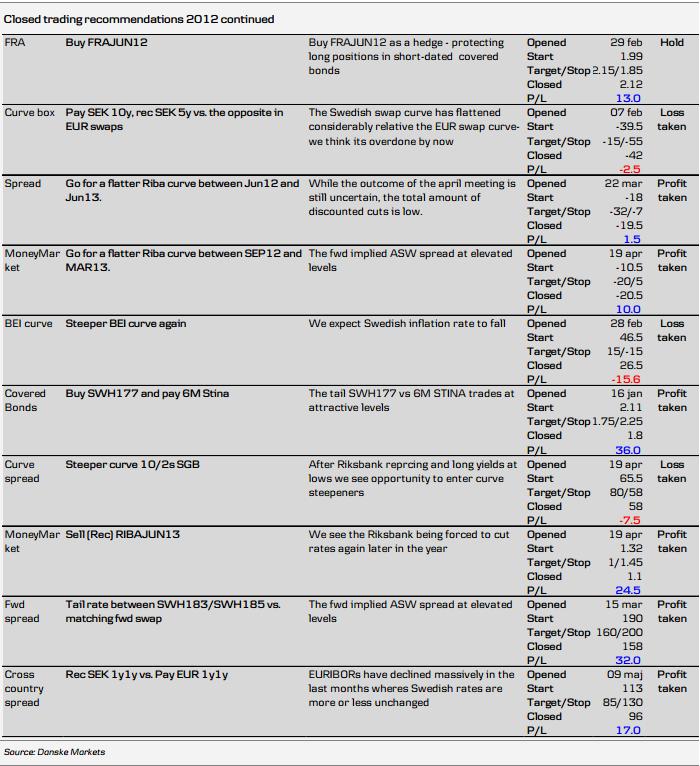
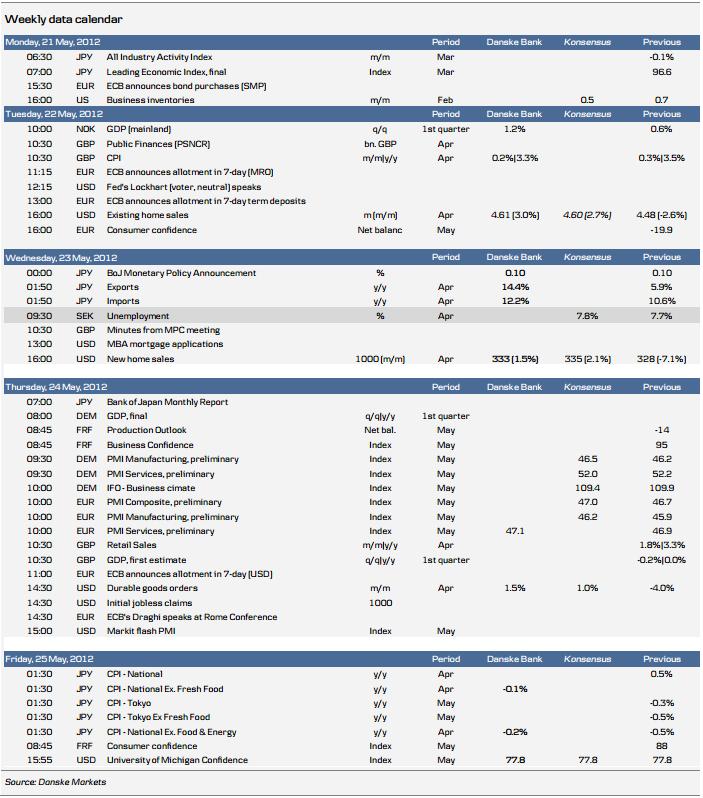
Disclosure
This research report has been prepared by Danske Research, a division of Danske Bank A/S (‘Danske Bank’).
The authors of this research report are Marcus Söderberg, Strategy/Quant Analyst, and Michael Grahn, Strategy/Macro Analyst.
Analyst certification
Each research analyst responsible for the content of this research report certifies that the views expressed in the research report accurately reflect the research analyst’s personal view about the financial instruments and issuers covered by the research report. Each responsible research analyst further certifies that no part of the compensation of the research analyst was, is or will be, directly or indirectly, related to the specific recommendations expressed in the research report.
Regulation
Danske Bank is authorised and subject to regulation by the Danish Financial Supervisory Authority and is subject to the rules and regulation of the relevant regulators in all other jurisdictions where it conducts business. Danske Bank is subject to limited regulation by the Financial Services Authority (UK). Details on the extent of the regulation by the Financial Services Authority are available from Danske Bank upon request. The research reports of Danske Bank are prepared in accordance with the Danish Society of Financial Analysts’ rules of ethics and the recommendations of the Danish Securities Dealers Association.
Conflicts of interest
Danske Bank has established procedures to prevent conflicts of interest and to ensure the provision of highquality research based on research objectivity and independence. These procedures are documented in Danske Bank’s research policies. Employees within Danske Bank’s Research Departments have been instructed that any request that might impair the objectivity and independence of research shall be referred to Research Management and the Compliance Department. Danske Bank’s Research Departments are organised independently from and do
not report to other business areas within Danske Bank.
Research analysts are remunerated in part based on the overall profitability of Danske Bank, which includes investment banking revenues, but do not receive bonuses or other remuneration linked to specific corporate finance or debt capital transactions.
Financial models and/or methodology used in this research report
Calculations and presentations in this research report are based on standard econometric tools and methodology as well as publicly available statistics for each individual security, issuer and/or country. Documentation can be obtained from the authors upon request.
Risk warning
Major risks connected with recommendations or opinions in this research report, including as sensitivity analysis of relevant assumptions, are stated throughout the text.
Date of first publication
See the front page of this research report for the date of first publication.
General disclaimer
This research has been prepared by Danske Markets (a division of Danske Bank A/S). It is provided for informational purposes only. It does not constitute or form part of, and shall under no circumstances be considered as, an offer to sell or a solicitation of an offer to purchase or sell any relevant financial instruments (i.e. financial instruments mentioned herein or other financial instruments of any issuer mentioned herein and/or options, warrants, rights or other interests with respect to any such financial instruments) (‘Relevant Financial Instruments’).
The research report has been prepared independently and solely on the basis of publicly available information that Danske Bank considers to be reliable. While reasonable care has been taken to ensure that its contents are not untrue or misleading, no representation is made as to its accuracy or completeness and Danske Bank, its affiliates and subsidiaries accept no liability whatsoever for any direct or consequential loss, including without limitation any loss of profits, arising from reliance on this research report.
The opinions expressed herein are the opinions of the research analysts responsible for the research report and reflect their judgement as of the date hereof. These opinions are subject to change and Danske Bank does not undertake to notify any recipient of this research report of any such change nor of any other changes related to the information provided in the research report.
This research report is not intended for retail customers in the United Kingdom or the United States.
This research report is protected by copyright and is intended solely for the designated addressee. It may not be reproduced or distributed, in whole or in part, by any recipient for any purpose without Danske Bank’s prior written consent.
Disclaimer related to distribution in the United States
This research report is distributed in the United States by Danske Markets Inc., a U.S. registered broker-dealer and subsidiary of Danske Bank, pursuant to SEC Rule 15a-6 and related interpretations issued by the U.S. Securities and Exchange Commission. The research report is intended for distribution in the United States solely to ‘U.S. institutional investors’ as defined in SEC Rule 15a-6. Danske Markets Inc. accepts responsibility for this research report in connection with distribution in the United States solely to ‘U.S. institutional investors’.
Danske Bank is not subject to U.S. rules with regard to the preparation of research reports and the independence of research analysts. In addition, the research analysts of Danske Bank who have prepared this research report are not registered or qualified as research analysts with the NYSE or FINRA but satisfy the applicable requirements of a non-U.S. jurisdiction.
Any U.S. investor recipient of this research report who wishes to purchase or sell any Relevant Financial Instrument may do so only by contacting Danske Markets Inc. directly and should be aware that investing in nonU.S. financial instruments may entail certain risks. Financial instruments of non-U.S. issuers may not be registered with the U.S. Securities and Exchange Commission and may not be subject to the reporting and auditing standards of the U.S. Securities and Exchange Commission.
